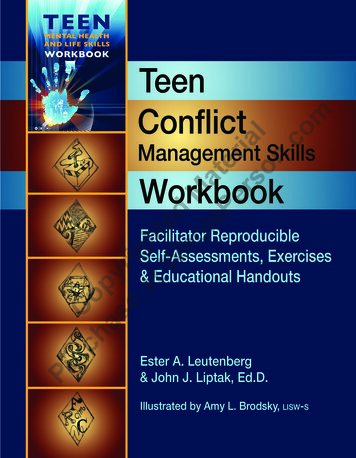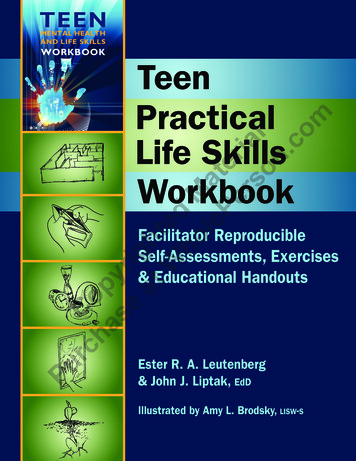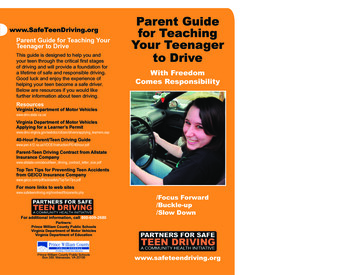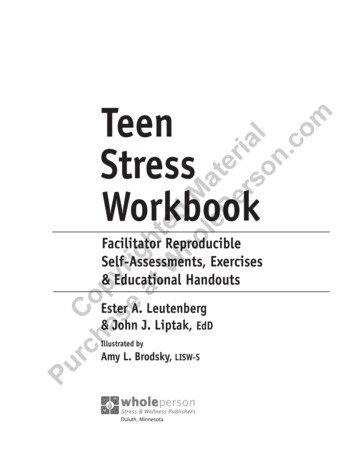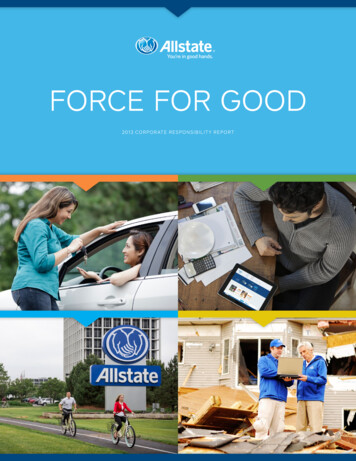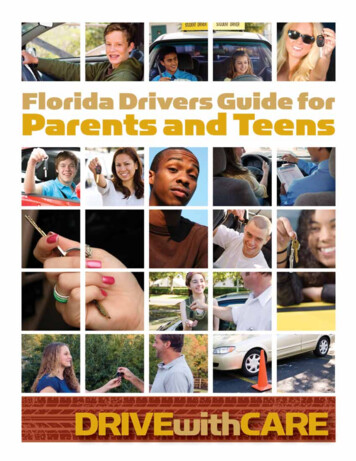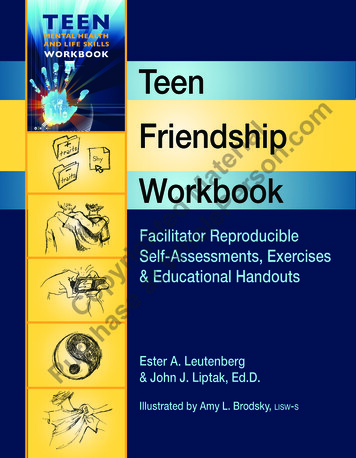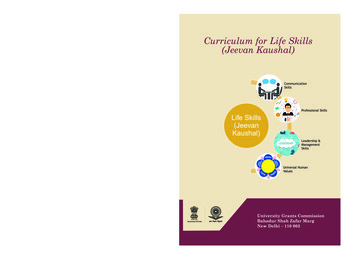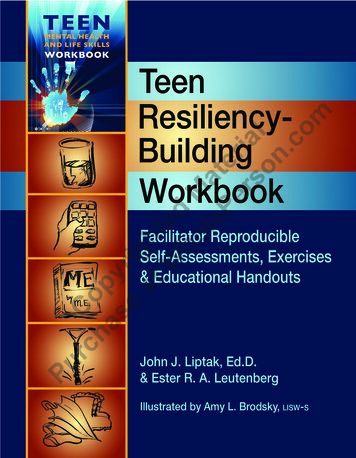
Transcription
TEENMENTAL HEALTHAND LIFE SKILLSWORKBOOKCch oas pye rigat hW tedho Mle atPe errs rcises& Educational Handouts& Educational HandoutsEster R. A. LeutenbergJohn J. Liptak, EdDIllustrated byPurAmy L. Brodsky, LISW-SJohn J. Liptak, Ed.D.& Ester R. A. LeutenbergIllustrated by Amy L. Brodsky, lisw-sDuluth, Minnesota
Cch oas pye rigat hW tedho Mle atPe errs ialon.comWhole Person101 W. 2nd St., Suite 203Duluth, MN son.comTeen Resiliency-Building WorkbookReproducible Self-Assessments, Exercises & Educational HandoutsCopyright 2012 by Ester R. A. Leutenberg and John J. Liptak.All rights reserved. Except for short excerpts for review purposesand materials in the assessment, journaling activities, andeducational handouts sections, no part of this book may bereproduced or transmitted in any form by any means, electronicor mechanical, including photocopying without permission inwriting from the publisher.All efforts have been made to ensure accuracy of the informationcontained in this book as of the date published. The author(s)and the publisher expressly disclaim responsibility for anyadverse effects arising from the use or application of theinformation contained herein.Printed in the United States of America10 9 8 7 6 5 4 3 2 1PurEditorial Director: Carlene SippolaArt Director: Joy Morgan DeyLibrary of Congress Control Number: 2010936856ISBN: 978-1-57025-263-1
Teen ResiliencyCch oas pye rigat hW tedho Mle atPe errs ialon.comAs they develop and mature, teens experience a great deal of stress in their lives. Forteens, the stress they experience can be from physical changes to psychological, social andemotional stressors, and these changes can cause depression, confusion, low self-esteem,a lack of self-identity and a sense of uncertainty. Some of this stress can come from thesesituations . . . Arguments and fights at home Divorce of parents, caregivers, or other family members Pressure to get better grades Need to be more independent Wish to be better at sports, music, drama, etc. Pressure from peers to smoke, drink, etc. Victim / Target of bullying Career choice decisions Education choices decisions Body change Make friendships and community relationships Incentive to prove maturity Pressure to earn money Will to gain respect of teachers and other adults in the school and community Challenges to keep up with peers Pressure to do things against better judgmentPurMany teens face challenges stemming from stress they experience at home, school, volunteeror work settings, and with their friends. The good news is that teens who develop resiliencecan avoid feeling overwhelmed with the amount of stress they experience. They are able tobounce back and be strong, efficient managers of their stress and live more effective lives.They accomplish this through building resiliency into their lives. Resiliency is a person’sability to cope with stress and hardship, bounce back to a normal state of functioning, andpromote overall well-being.(Continued)
Facts about ResiliencyCch oas pye rigat hW tedho Mle atPe errs ialon.comBuilding resiliency is critical in the life of teens. It is currently called a host of other namesincluding hardiness, psychological resilience, emotional resourcefulness, and mentalresiliency. Regardless of the name you choose, resiliency is the ability of a teen to interact withthe environment, handle stresses that occur, and bounce back from these stressful events. Itis the process by which well-being is promoted and protection factors are activated againstoverwhelming feelings of stress. Teens who have developed resiliency are able to bounce backfrom the negative impact of difficulties.Resiliency can be thought of as a skill that allows teens to manage life’s challenges, stresses, changes, and pressures effectively. cope with and adapt successfully to adversity. bounce back to a balanced state after facing a major disruption in lifeor career planning.Teens have an innate ability to demonstrate resiliency as they build resiliency skills intotheir lives. Resilient people are able to adapt successfully under adverse circumstances suchas poverty, mental illness, disasters, terrorism, physical or psychological trauma, parents’divorce, parent’s job loss and financial problems, family members in prison, loss of a lovedone, peer pressure, physical or sexual abuse, self-induced pressure to achieve in school, or alack of safety. Resiliency, or a positive behavioral adaptation, is critical when people encounterany type of trauma.Research shows that resiliency offers protection from distress and illness in the face of changeor adversity. The presence of high levels of resiliency is associated with these factors: highlevel of happiness, self-esteem, sense of energy and vitality, optimism, self-reported health,sense of meaning and direction, and a low level of depression.PurTeens who are resilient work hard at school work and study because they enjoy it and want to achieve react in optimistic ways see problems and difficult situations as challenges take positive risks and actions think of changes as natural go with the flow have a high self-esteem, self-confidence, self-concept and sense of self thrive under challenging situations believe that they can influence events and their reactions to events recognize that with good stress comes growth have hope for their future overcome obstacles with confidence create goals and work at accomplishing them possess a keen sense of control over their life bounce-back from disappointmentsResearch also indicates that resiliency can be built through skill development by enhancingcommunication, developing an optimistic outlook, building a greater sense of control, creatinga more realistic sense of self, and learning how to effectively deal with change. The purpose ofthis workbook is to provide teens with the requisite skills they need to manage their emotionsand to develop and maintain resiliency.(Continued)
Using This BookThe Teen Resiliency-Building Workbook contains five separate sections to help participants learnmore about themselves and how to build the resiliency which will enable them to thrive in timesof adversity, change and stress. They will learn about the importance of building resiliency skillsto turn change and stress into opportunities and challenges, to live life zestfully, and to takepositive actions in order to live their lives with less stress.Cch oas pye rigat hW tedho Mle atPe errs ialon.comSections of this Book1) OPTIMISTIC OUTLOOK SCALE helps teens identify how optimistically they view and live life.2) SENSE OF CONTROL SCALE helps teens explore the extent to which they believe they havecontrol over what happens in their lives.3) SENSE-OF-SELF SCALE helps teens explore the strength of their self-esteem, self-confidenceand self-concept.4) ABILITY TO BOUNCE BACK SCALE helps teens increase their ability to bounce back andrecover from a setback.5) TYPES OF CHANGE SCALE helps teens to become aware of how well they deal with change,and to develop skills necessary to accept change.These sections serve as avenues for individual self-reflection and participation in groupexperiences revolving around identified topics of importance. Each assessment includesdirections for easy administration, scoring and interpretation. Each section includes exploratoryactivities, reflective journaling activities and educational handouts to help participants discovertheir own levels of resiliency. Reflective exercises and instruction also help participants to buildpersonal and professional resiliency.By combining reflective assessment and journaling, participants will be exposed to a powerfulmethod of combining verbalizing and writing to reflect on and to solve problems. Participantswill become more aware of the strength and weaknesses of their resiliency and find ways to buildand enhance their hardiness.Preparation for using the assessments and activities in this book is important.The authors suggest that prior to administering any of the assessments in thisbook, you complete them yourself. This will familiarize you with the format of theassessments, the scoring directions, the interpretation guides and the journalingactivities. Although the assessments are designed to be self-administered, scored andinterpreted, this familiarity will help facilitators prepare to answer questions aboutthe assessments.Use Codes for ConfidentialityPurConfidentiality is a term for any action that preserves the privacy of other people. Because teenscompleting the activities in this workbook might be asked to answer assessment items and tojournal about and explore their relationships, the group will need to discuss confidentiality beforeyou begin using the materials in this workbook. Maintaining confidentiality is important becauseit shows respect for others and allows participants to explore their feelings without hurtinganyone’s feelings or fearing gossip, harm or retribution.In order to maintain confidentiality, explain to the participants that they need to assign a name codefor each person or each group of people they write about as they complete the various activitiesin the workbook. For example, a friend named Joey who enjoys going to hockey games might betitled JLHG (Joey Loves Hockey Games) for a particular exercise. In order to protect their friends’identities, they should not use people’s or groups’ actual names or initials, just name codes.
The Assessments, Journaling Activities,and Educational HandoutsCch oas pye rigat hW tedho Mle atPe errs ialon.comThe Assessments, Journaling Activities, and Educational Handouts in the Teen ResiliencyBuilding Workbook are reproducible and ready to be photocopied for participants’ use.Assessments contained in this book focus on self-reported data and are similar to those usedby psychologists, counselors, therapists and marriage and family therapists. Accuracy andusefulness of the information provided is dependent on the truthful information that eachparticipant provides through self-examination. By being honest, teens help themselves tolearn more about how they respond and react to stress, change, and adversity in their lives,and to uncover information that might be keeping them from being as happy and/or assuccessful as they might be.An assessment instrument can provide participants with valuable information aboutthemselves; however, it cannot measure or identify everything about them. The purpose ofthe assessments is not to pigeon-hole certain characteristics, but rather to allow participantsto explore all of their characteristics. This book contains self-assessments, not tests. Testsmeasure knowledge or whether something is right or wrong. For the assessments in thisbook, there are no right or wrong answers. These assessments ask for personal opinions orattitudes about a topic of importance in the participant’s career and life.When administering assessments in this workbook, remember that the items are genericallywritten so that they will be applicable to a wide variety of people. They will not account forevery possible variable for every person. The assessments are not specifically tailored to oneperson. Use them to help participants identify possible negative themes in their lives and tofind ways to break the hold that these patterns and their effects have.Advise teen participants taking the assessments they should not spend too much time tryingto analyze the content of the questions; their initial response to each item will most likelybe true. Regardless of individual scores, encourage participants to write and talk abouttheir findings and their feelings pertaining to what they have discovered about themselves.Resilient teens are able to adapt successfully and cope with stress and catastrophe. Theyhave the ability to bounce back to a balanced state after disruption or transition. Exploringresiliency-building exercises will be helpful to the teens now and as they mature intoadulthood.PurA particular score on any assessment does not guarantee a participant’s level ofhappiness. Use discretion when using any of the information or feedback provided in thisworkbook. The use of these assessments should not be substituted for consultation and/orcounseling from a psychological or medical professional.Thanks to the following professionals whose input in this book has been so valuable!Kathy Khalsa, OTR/LJay LeutenbergKathy Liptak, Ed.D.Eileen Regen, M.Ed., CJE
Layout of the BookThe Teen Resiliency-Building Workbook is designed to be used either independently or as partof an integrated curriculum. You may administer one of the assessments and the journalingexercises to an individual or a group with whom you are working, or you may administer anumber of the assessments over one or more days.Cch oas pye rigat hW tedho Mle atPe errs ialon.comThis book includes the following reproducible pages in the first five sections: Assessment Instruments – Self-assessment inventories with scoring directions andinterpretation materials. Group facilitators can choose one or more of the activitiesrelevant to their participants. Activity Handouts – Practical questions and activities that prompt self-reflection andpromote self-understanding. These questions and activities foster introspection andpromote pro-social behaviors. Quotations – Quotations are used in each section to provide insight and promotereflection. Participants will be asked to select one or more of the quotations and journalabout what the quotations mean to them. Reflective Questions for Journaling – Self-exploration activities and journalingexercises specific to each assessment to enhance self-discovery, learning, and healing. Educational Handouts – Handouts designed to enhance instruction can be used byindividuals or in groups to promote a positive understanding of managing conflict. Theycan be distributed, scanned and converted into masters for overheads or transparencies,projected or written on boards and/or discussed.Who Should Use This Program?This book has been designed as a practical tool for helping professional therapists,counselors, marriage and family therapists, psychologists, teachers, group leaders, etc.Depending on the role of the professional using the Teen Resiliency-Building Workbookand the specific group’s needs, these sections can be used individually, combined, orimplemented as part of an integrated curriculum for a more comprehensive approach.Why Use Self-Assessments?Pur Self-assessments are important in teaching various anger management skills becausethey help participants to engage in these ways: Become aware of the primary motivators that guide their behavior Explore and learn to “let go” of troublesome habits and behavioral patterns learned inchildhood Examine the effects of unconscious childhood messages Gain insight and “a wake-up call” for behavioral change Focus thinking on behavioral goals for change Uncover personal resources that can help them to cope better with problems anddifficulties Explore personal characteristics without judgmentIdentify personal strengths and weaknessesBecause the assessments are presented in a straightforward and easy-to-useformat, individuals can self-administer, score and interpret each assessment attheir own pace.
Introduction for the ParticipantCch oas pye rigat hW tedho Mle atPe errs ialon.comThe media sometimes portrays the teen years as easy, happy-go-lucky years in which youwear the right clothes, fit in well with all your friends, have a great home life and do wellin school. As you know, life as a teen can be very different from that image. You may faceproblems at home, relationship issues, bullying, school situations and experience the lossof loved ones. Why are some people able to go through really rough times and bounce back,while others are unable to do so? Resiliency!Resiliency is described as your ability to bounce back and cope with challenges in your life.Resiliency is the ability to . . . deal effectively with stress and adversity successfully handle changes in life withstand grief and accept loss creatively adapt to life challenges.Psychologically resilient teens tend to have less stress, anxiety and depression. They tend todo better in school, home, work or volunteer jobs and with friends and in the community.Remember the building-resiliency process is a personal journey that can help you developlifelong skills to strengthen your ability to adapt to change and cope with stress.The Teen Resiliency-Building Workbook is designed to help you learn more about yourself;identify the stresses and challenges in your life; explore how you have dealt with adversity inthe past; develop resiliency skills and a resiliency mindset; and find better ways to use thesenewfound skills to deal effectively with whatever setbacks you encounter in life. You willbe encouraged to complete assessments, journaling activities and exercises. Because activeinvolvement and “doing” is as important as learning theories, it is critical that you take thetime to complete all of the skill-building exercises.ConfidentialityPurYou will be asked to respond to assessments and exercises, and to journal about someexperiences in your relationships. Everyone has the right to confidentiality, and you need tohonor the right of privacy of the people you may be writing about. Think about it this way– you would not want someone writing things about you that other people could read. Yourfamily, friends and anyone else you include in the exercises deserve this respect also.In order to maintain the confidentiality of your friends and family members, assign codenames to people or groups, based on things you know about them. For example, a friendnamed Sherry who loves to wear purple might be coded as SWP (Sherry Wears Purple).Do not use any person’s or group’s actual name when you are listing people orgroups of people – use only name codes.
Teen Building Resiliency WorkbookTABLE OF CONTENTSSection I: Optimistic Outlook ScaleCch oas pye rigat hW tedho Mle atPe errs ialon.comOptimistic Outlook ScaleDirections . . . . . . . . . . . . . . . . . . . . . . . . . . . . . . . . . . . . . . . . 15Scale . . . . . . . . . . . . . . . . . . . . . . . . . . . . . . . . . . . . . . . . . 16–17Scoring Directions . . . . . . . . . . . . . . . . . . . . . . . . . . . . . . . . . . . 18Profile Interpretation . . . . . . . . . . . . . . . . . . . . . . . . . . . . . . . . 18ExercisesHope . . . . . . . . . . . . . . . . . . . . . . . . . . . . . . . . . . . . . . . . . 19–20Life Outlook . . . . . . . . . . . . . . . . . . . . . . . . . . . . . . . . . . . . . . . 21Optimistic Friends in My Life . . . . . . . . . . . . . . . . . . . . . . . . . . 22Pessimistic Friends in My Life . . . . . . . . . . . . . . . . . . . . . . . . . 23Reconstructing My Attitude . . . . . . . . . . . . . . . . . . . . . . . . . . . 24Obstacles in My Life . . . . . . . . . . . . . . . . . . . . . . . . . . . . . . . . . 25My School/ Volunteers / Work Obstacles . . . . . . . . . . . . . . . . . . 26Overcoming Obstacles . . . . . . . . . . . . . . . . . . . . . . . . . . . . . . . 27Building an Optimistic Outlook . . . . . . . . . . . . . . . . . . . . . . . . 28Creating Goals . . . . . . . . . . . . . . . . . . . . . . . . . . . . . . . . . . . . . 29Journaling ActivitiesOptimism Quotes . . . . . . . . . . . . . . . . . . . . . . . . . . . . . . . . . . . 30My Plan . . . . . . . . . . . . . . . . . . . . . . . . . . . . . . . . . . . . . . . . . . . 31Educational HandoutsBenefits of Optimism . . . . . . . . . . . . . . . . . . . . . . . . . . . . . . . . 32Optimism . . . . . . . . . . . . . . . . . . . . . . . . . . . . . . . . . . . . . . . 33Section II: Sense of Control ScalePurSense of Control ScaleDirections . . . . . . . . . . . . . . . . . . . . . . . . . . . . . . . . . . . . . . . . 37Scale . . . . . . . . . . . . . . . . . . . . . . . . . . . . . . . . . . . . . . . . . 38–39Scoring Directions . . . . . . . . . . . . . . . . . . . . . . . . . . . . . . . . . . . 40Profile Interpretation . . . . . . . . . . . . . . . . . . . . . . . . . . . . . . . . 40
TABLE OF CONTENTSExercisesCch oas pye rigat hW tedho Mle atPe errs ialon.comThe Development of Sense of Control . . . . . . . . . . . . . . . . . . . 41Contributing to My Successes . . . . . . . . . . . . . . . . . . . . . . . . . 42My Disappointments . . . . . . . . . . . . . . . . . . . . . . . . . . . . . . . . 43Gaining More Control over My Daily Life . . . . . . . . . . . . . . . . . 44Action Plan . . . . . . . . . . . . . . . . . . . . . . . . . . . . . . . . . . . . . 45–50To Know What I Can and Cannot Control . . . . . . . . . . . . . . . . . 51Journaling ActivitiesSense of Control Quotes . . . . . . . . . . . . . . . . . . . . . . . . . . . . . 52Your Sense of Control . . . . . . . . . . . . . . . . . . . . . . . . . . . . . . . 53Educational HandoutsTo Change Your Sense of Control . . . . . . . . . . . . . . . . . . . . 54Results of a Healthy Sense of Control . . . . . . . . . . . . . . . . . . . 55Section III: Sense-of-Self ScaleSense-of-Self ScaleDirections . . . . . . . . . . . . . . . . . . . . . . . . . . . . . . . . . . . . . . . . 59Scale . . . . . . . . . . . . . . . . . . . . . . . . . . . . . . . . . . . . . . . . . . . . 60Scoring Directions . . . . . . . . . . . . . . . . . . . . . . . . . . . . . . . . . . . 61Scale Profile Interpretation . . . . . . . . . . . . . . . . . . . . . . . . . . . . 61ExercisesSense-of-Self . . . . . . . . . . . . . . . . . . . . . . . . . . . . . . . . . . . . . . . 62Self-Esteem – My Good Points . . . . . . . . . . . . . . . . . . . . . . 63–64Self-Criticisms . . . . . . . . . . . . . . . . . . . . . . . . . . . . . . . . . . . . . 65Self-Concept . . . . . . . . . . . . . . . . . . . . . . . . . . . . . . . . . . . . 66–67Self-Confidence – Role Models . . . . . . . . . . . . . . . . . . . . . . . . . 68PurSelf-Confidence – Comparisons . . . . . . . . . . . . . . . . . . . . . . . . 69Self-Confidence – My Successes . . . . . . . . . . . . . . . . . . . . . . . . 70Self-Confidence – Taking Positive Risks . . . . . . . . . . . . . . . 71-72
TABLE OF CONTENTSJournaling ActivitiesCch oas pye rigat hW tedho Mle atPe errs ialon.comSense-of-Self Quotations . . . . . . . . . . . . . . . . . . . . . . . . . . . . . 73My Characteristics . . . . . . . . . . . . . . . . . . . . . . . . . . . . . . . . . . 74Sense-of-Self and Resilience . . . . . . . . . . . . . . . . . . . . . . . . . . . 75Educational HandoutsThe Sense-of-Self Circle . . . . . . . . . . . . . . . . . . . . . . . . . . . . . . . 76Facts about Sense-of-Self . . . . . . . . . . . . . . . . . . . . . . . . . . . . . 77Section IV: Ability to Bounce Back ScaleAbility to Bounce Back ScaleDirections . . . . . . . . . . . . . . . . . . . . . . . . . . . . . . . . . . . . . . . . 81Scale . . . . . . . . . . . . . . . . . . . . . . . . . . . . . . . . . . . . . . . . . . . . 82Scoring Directions . . . . . . . . . . . . . . . . . . . . . . . . . . . . . . . . . . . 83Profile Interpretation . . . . . . . . . . . . . . . . . . . . . . . . . . . . . . . . 83ExercisesOvercoming a Victim Mentality . . . . . . . . . . . . . . . . . . . . . . . . 84Overcoming Negative Messages . . . . . . . . . . . . . . . . . . . . . . . 85Invest in Yourself . . . . . . . . . . . . . . . . . . . . . . . . . . . . . . . . . . . 86Take More Responsibility . . . . . . . . . . . . . . . . . . . . . . . . . . . . . 87Learn from Your Experiences . . . . . . . . . . . . . . . . . . . . . . . . . . 88Excuses . . . . . . . . . . . . . . . . . . . . . . . . . . . . . . . . . . . . . . . . . . . 89Staying in the Present vs. Dwelling on the Past . . . . . . . . . . . . 90Prepare for the Future . . . . . . . . . . . . . . . . . . . . . . . . . . . . 91–92Get What You Feel You Deserve . . . . . . . . . . . . . . . . . . . . . . . . 93Focus and Commitments . . . . . . . . . . . . . . . . . . . . . . . . . . . . . 94Journaling ActivitiesPurBounce-Back Quotations . . . . . . . . . . . . . . . . . . . . . . . . . . . . . 95I Learned . . . . . . . . . . . . . . . . . . . . . . . . . . . . . . . . . . . . . . . 96Handling it Differently . . . . . . . . . . . . . . . . . . . . . . . . . . . . . . . 97Educational HandoutsWays to Develop a Bounce-Back Mentality . . . . . . . . . . . . . . . . 98Reasons People Maintain a Victim Mentality . . . . . . . . . . . . . . . 99
TABLE OF CONTENTSSection V: Types of Change ScaleCch oas pye rigat hW tedho Mle atPe errs ialon.comTypes of Change ScaleDirections . . . . . . . . . . . . . . . . . . . . . . . . . . . . . . . . . . . . . . . 103Scale . . . . . . . . . . . . . . . . . . . . . . . . . . . . . . . . . . . . . . . 104–105Scoring Directions . . . . . . . . . . . . . . . . . . . . . . . . . . . . . . . . . . 106Profile Interpretation . . . . . . . . . . . . . . . . . . . . . . . . . . . . . . . 106Scale Descriptions . . . . . . . . . . . . . . . . . . . . . . . . . . . . . . . . . . 107ExercisesExploring Change . . . . . . . . . . . . . . . . . . . . . . . . . . . . . . . . . . 108When Change Occurs . . . . . . . . . . . . . . . . . . . . . . . . . . . . . . . 109Changes in Your Life . . . . . . . . . . . . . . . . . . . . . . . . . . . . . . . 110My Strength and Skills/Abilities . . . . . . . . . . . . . . . . . . . . . . . 111Feelings . . . . . . . . . . . . . . . . . . . . . . . . . . . . . . . . . . . . . . . . . 112Acknowledging Feelings . . . . . . . . . . . . . . . . . . . . . . . . . . . . 113Regaining Control . . . . . . . . . . . . . . . . . . . . . . . . . . . . . . . . . . 114Support . . . . . . . . . . . . . . . . . . . . . . . . . . . . . . . . . . . . . . . . . . 115Influence . . . . . . . . . . . . . . . . . . . . . . . . . . . . . . . . . . . . . . . . 116Journaling ActivitiesQuotations about Change . . . . . . . . . . . . . . . . . . . . . . . . . . . 117Managing Change Effectively . . . . . . . . . . . . . . . . . . . . . 118–119Educational HandoutsChange Can Be . . . . . . . . . . . . . . . . . . . . . . . . . . . . . . . . . . . 120PurManaging Stress During a Change . . . . . . . . . . . . . . . . . . . . . 121
SECTION I:Cch oas pye rigat hW tedho Mle atPe errs ialon.comOptimisticOutlookScalePurNameDate 2012 WHOLE PERSON ASSOCIATES, 101 W. 2ND ST., SUITE 203, DULUTH MN 55802 800-247-678913
Cch oas pye rigat hW tedho Mle atPe errs ialon.comPur14 2012 WHOLE PERSON ASSOCIATES, 101 W. 2ND ST., SUITE 203, DULUTH MN 55802 800-247-6789
SECTION I: OPTIMISTIC OUTLOOK SCALEOptimistic Outlook Scale DirectionsCch oas pye rigat hW tedho Mle atPe errs ialon.comSome people see the glass half full, while others see it half empty. Those who see the glasshalf full are optimists; those who see the glass half empty are pessimists. As an optimist,regardless of transitions, setbacks, or disappointments, the person looks at the bright sideand sees the possibilities life has to offer. Optimists expect good things to happen, expect tobe able to solve problems efficiently, and plan to accomplish their life and work goals. Theygo through life with positive outlooks and are content most of the time.Optimists maintain a positive world-view. Pessimists think negatively and cynically aboutthe world. The Optimistic Outlook Scale is designed to help you assess your outlook whennegative and positive things happen in your life.This scale contains 40 statements that are divided into four resiliency categories. Readeach of the statements and decide whether or not the statement describes you. For eachof the statements listed, circle the number of your response on the line to the right of eachstatement.In the following example, the circled 4 indicates the statement is very much like the personcompleting the assessment:Very Much Usually Not UsuallyNotLike MeLike MeLike MeLike Me1. When things go wrong, I remain hopeful4321PurThis is not a test and there are no right or wrong answers. Do not spend too much timethinking about your answers. Your initial response will be the most true for you. Be sure torespond to every statement.(Turn to the next page and begin) 2012 WHOLE PERSON ASSOCIATES, 101 W. 2ND ST., SUITE 203, DULUTH MN 55802 800-247-678915
SECTION I: OPTIMISTIC OUTLOOK SCALEOptimistic Outlook ScaleVery Much Usually Not UsuallyNotLike MeLike MeLike MeLike Me3212. A lot of situations do not have a “silver lining” . . . . . . . 12343. I can always see the light at the end of the tunnel. . . . 43214. I often feel hopeless. . . . . . . . . . . . . . . . . . . . . . . . . . . 12345. I look on the bright side of things. . . . . . . . . . . . . . . . . 43216. I’m usually optimistic about my future . . . . . . . . . . . . . 43217. I am unhappy a lot of the time . . . . . . . . . . . . . . . . . . . 12348. I rarely get depressed when I think about the future. . . 43219. I do not wait for happiness to find me . . . . . . . . . . . . . 432110. I often feel helpless when things change. . . . . . . . . . . 1234Cch oas pye rigat hW tedho Mle atPe errs ialon.com1. When things go wrong, I remain hopeful . . . . . . . . . . . 4H - TOTAL 32112. If something can go wrong, it will . . . . . . . . . . . . . . . . 123413. I usually expect things to go my way . . . . . . . . . . . . . . 432114. Things usually don’t work out the wayI want them to . . . . . . . . . . . . . . . . . . . . . . . . . . . . . . . 123415. I am afraid to hope that good things willhappen to me. . . . . . . . . . . . . . . . . . . . . . . . . . . . . . . . 123416. I often say “good things never happen to me”. . . . . . . 123417. My life is filled with problems. . . . . . . . . . . . . . . . . . . . 123418. Even i
Using This Book. The . Teen Resiliency-Building Workbook. contains five separate sections to help participants learn more about themselves and how to build the resiliency which will enable them to thrive in times of adversity, change and stress. They will
